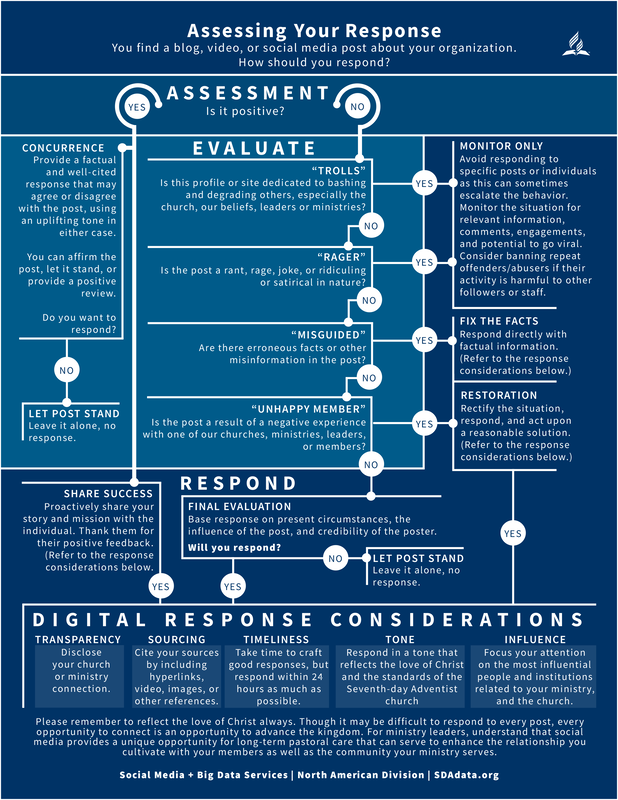Jamie Jean Schneider DommDigital Strategist, Social Media + Big Data, North American Division As states begin to issue “shelter in place” orders for residents, many find themselves stuck at home and unable to serve their church members and community in the usual ways. However, we are still called to minister to others. Remember, the church is not a building, it’s a people. When fleeing persecution, the early church took the gospel to new regions out of necessity. So, too, we must now take the gospel message to the digital mission field and spread our message of hope and wholeness when it is needed most. Digital tools can be used in many ways to extend the church experience beyond the building and help those in your community who are struggling financially, spiritually, and emotionally. God’s kingdom is 24/7, and now is the time to embrace digital evangelism and discipleship for growing and sustaining His Church. Here are 10 easy ways you can serve your community using digital tools during COVID-19:
Physical distancing doesn’t mean we have to grow apart.These are just a few ways to utilize the technologies we use every day to grow a vibrant community that will come back stronger and more unified from this experience.
Visit SDAdata.org/goingdigitalcovid19 for more resources to help your church or ministry go digital during COVID-19. Do you have more ideas about how to use digital tools to serve your community during COVID-19? Share them below! Jamie Jean Schneider Domm Digital Strategist, Social Media + Big Data, North American Division  Content creation, engagement, and distribution are not limited to the official church brand and accounts. Make it a point to reach out to young people and let them know that their talents in this area are highly valued even if they are not part of the core team. Some people just need permission and a little mentorship to realize their talents and passion for personal ministry. Everyone has social influence through texting, messenger applications, email, and social media. Encourage and inspire them to use it to build God's kingdom. The two primary roles in which digital disciples can serve are as engagers and distributors. For this reason, I have decided to unpack the role of digital disciples here in the guide, in-between these two sections of the digital discipleship and evangelism model. The Bible tells us to become and make disciples. God calls us all to serve in unique ways. Ellen White encourages us to: Let every worker in the Master’s vineyard, study, plan, devise methods, to reach the people where they are. We must do something out of the common course of things. We must arrest the attention. We must be deadly in earnest. We are on the very verge of times of trouble and perplexities that are scarcely dreamed of. – Ellen White, Letter 20, 1893 Identify people in your church who can be digital disciples, all on their own, as a means to further the mission of your church. This allows and empowers members to engage in ministry and discipleship in ways that aligns with their passion, spiritual gifts, tools of preference, and personal style. There is a spiritual void online because we are not doing enough individually as members or collectively as a Church. The mission field is wide open, it’s our duty to share the gospel through the tools available to us. The Great Commission given to us by Jesus Christ states, “Go, therefore, and make disciples of all the nations” (Matthew 28:19). An easy and free way to reach the nations lies in the palms of our hands. When we hesitate to make the gospel message more available, we allow our own human weaknesses and fears to get in the way of our mission. How can we justify this resistance to boldly declaring our faith online? We live in an era of religious freedom with minimal persecution in North America (in contrast to what is happening in other parts of the world). However, the predominant perception among the Church body is that evangelism is an event run exclusively by a specific set of people. In Exodus 4:2, God asks Moses “What is in your hand?” and tells him to lead the children of Israel to the promised land. To Moses, his staff is simply a tool for directing sheep, but with God’s direction, it becomes an instrument through which miracles are performed. If God spoke to each of us today, we would answer, “a phone,” a “laptop,” or an “iPad.” Most of us have a smart phone that can be used either for distraction or for positive impact. The responsibility of every disciple is to utilize every available resource for God so at the end of the age, when we face our Master, we will hear, “Well done, good and faithful servant!...” (Matthew 25:23). We must commit to work diligently online to share present truth, regardless of who we are and what our official role may be in the Church. Tips and Ideas for Individual Digital Disciples, |
Archives
August 2020
Categories
All
|
- Home
- BLOG
-
RESOURCES
-
RESOURCE MENU
>
- ADVENTIST IDENTITY GUIDELINES
- BIG DATA RESOURCES
- BRANDING, IMAGE & DESIGN RESOURCES
- CHURCH/MINISTRY SPECIFIC RESOURCES
- COPYRIGHT & TRADEMARK BASICS
- COURSES
- EMAIL RESOURCES
- GUIDANCE FOR HIRING SOCIAL MEDIA POSITIONS
- PODCASTS
- REPORTS & CASE STUDIES
- SOCIAL MEDIA RESOURCES
- (SOCIAL) VIDEO RESOURCES >
- TEXTING 4 CHURCHES
- TRACKING & ANALTYICS
- WATCH VIDEOS & TUTORIALS
- WEBSITE TIPS
- SOCIAL MEDIA GUIDELINES
-
RESOURCE MENU
>
- SEO
- Digital Discipleship & Evangelism
- COVID-19 RESOURCES
- eNEWSLETTER












 RSS Feed
RSS Feed